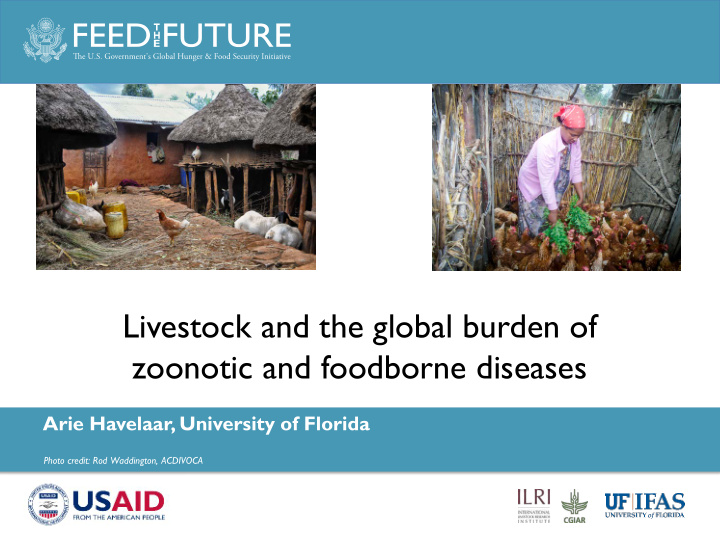



Livestock and the global burden of zoonotic and foodborne diseases Arie Havelaar, University of Florida Photo credit: Rod Waddington, ACDIVOCA Photo Credit Goes Here
ANIMALS AS RESERVOIRS OF EMERGING INFECTIOUS DISEASES • 61% of known human pathogens Number of EID events and reservoirs per decade have animal reservoirs • 60-75% of emerging infectious diseases are zoonotic • 72% of these originate from wildlife (Taylor et al., Philos Trans R Soc Lond B Biol Sci. 2001) (Jones et al., Nature 2008)
LIVESTOCK RELATED ZOONOSES Pandemic threats (e.g. MERS coronavirus) • Low incidence, potentially transmissible between humans • High case-fatality ratio • High fear factor: emerging zoonoses • Endemic zoonoses (e.g. salmonellosis) • High incidence, low transmission between humans • Low case-fatality ratio or long incubation period • Low fear factor: neglected tropical diseases • LSIL focus is on endemic zoonoses •
WHO ESTIMATES OF THE GLOBAL BURDEN OF FOODBORNE DISEASES Global estimates for 31 hazards • 11 acute diarrheal disease; 7 invasive infectious disease; 10 helminths; 3 chemicals • 13 livestock-related pathogens • 5 acute diarrheal disease; 4 invasive infectious disease; 4 helminths • Document current and future burden (sequelae, chronic exposures) • Illnesses, deaths, Disability Adjusted Life Years • Attribution to food and other pathways •
TRANSMISSION PATHWAYS OF ENDEMIC LIVESTOCK RELATED ZOONOSES Wagenaar et al., Clin Infect Dis. 2013;57(11):1600-1606
WHO (SUB)REGIONS EUR C EUR A AMR A EUR B WPR B EMR B SEAR D AFR D EMR D SEAR B AMR B AMR D AFR E WPR A
ATTRIBUTION
GLOBAL BURDEN OF FOODBORNE DISEASE, 2010 Hazard Foodborn Foodborn Foodborn group e illnesses e deaths e DALYs (millions) (thousand (millions) s) All 600 420 33 Diarrheal 549 230 18 Invasive 36 117 8 Helminths 13 45 6 Chemicals 0.2 19 0.9
BURDEN OF LIVESTOCK RELATED ZOONOSES Incidence (millions) Deaths (thousands) DALYs (millions)
DALYS BY PATHOGEN
ATTRIBUTION TO FOOD GROUPS Food Campylo- STEC Salmonell Crypto- Giardia Brucella E. T oxoplas group bacter a sporidium granulosis ma Poultry 38-55 17-35 6-14 Pork 0-16 4-24 2-22 Beef 5-17 7-54 1-9 3-5 18-34 SR meat 4-11 7-26 2-7 3-19 8-44 Dairy 4-15 13-17 2-6 2-8 68-91 Eggs 9-26 Fruits 0-3 1-12 1-7 23-31 26-34 21-23 2-7 Vegetables 3-33 9-17 5-9 56-65 63-81 77-78 14-23 Range of median proportions of disease attributed to different food groups by pathogen across subregions Hoffmann et al., submitted for publication
GLOBAL DISTRIBUTION OF THE BURDEN OF 13 LIVESTOCK RELATED ZOONOSES
ZOONOSES CAUSING HIGHEST BURDEN PER REGION AFR AMR EMR EUR SEAR WPR Non-typhoidal Toxoplasma gondii Campylobacter spp.Non-typhoidal Non-typhoidal Taenia solium S. enterica S. enterica S. enterica Taenia solium Non-typhoidal Non-typhoidal Toxoplasma gondii Campylobacter spp. Campylobacter spp. S. enterica S. enterica Campylobacter spp. Taenia solium Cryptosporidium Campylobacter spp. Cryptosporidium Toxoplasma gondii spp. spp. Cryptosporidium Campylobacter spp. Toxoplasma gondii Echinococcus Taenia solium Non-typhoidal spp. granulosus S. enterica Toxoplasma gondii Cryptosporidium Brucella spp. Brucella spp. Toxoplasma gondii Cryptosporidium spp. spp.
CHILDREN UNDER FIVE YEARS OF AGE … … make up 9% of the world population • … suffer from 38% of all foodborne illnesses • … succumb to 30% of foodborne deaths • … bear 40% of global foodborne DALYs •
PEOPLE LIVING IN THE POOREST AREAS OF THE WORLD … … make up 41% of the world population • … suffer from 53% of all foodborne illnesses • … succumb to 75% of foodborne deaths • … bear 72% of global foodborne DALYs • D and E subregions: high child and high – very high adult mortality •
LIMITATIONS OF WHO RESULTS Data availability and quality • Particularly in low-income countries where burden is highest • Imputation and expert judgment • Presentation at regional level rather than country level Large uncertainty intervals Underestimation • Limited number of hazards Not all endpoints considered, e.g. malnutrition and stunting; irritable bowel syndrome; chronic (psychiatric) consequences of toxoplasmosis Burden in HIV-positives preventable by food safety interventions Model uncertainty, e.g. multiplicative or additive models for chemicals Public health metrics do not quantify the full societal impact of foodborne diseases; economic burden
THE VICIOUS CYCLES OF DISEASES OF POVERTY Guerrant, R. L. et al. Nat. Rev. Gastroenterol. Hepatol. 2013;10:220-229.
ANIMAL OWNERSHIP, CHILD GROWTH AND ENVIRONMENTAL ENTERIC DYSFUNCTION Relationships between animal ownership and child growth are complex • Several studies report net beneficial effects • Beneficial effects can be reduced or even negated by exposure of children to • animal feces Headey et al. (2016) – Ethiopia • Poultry ownership beneficial; poultry but not larger animals in home overnight detrimental • Headey et al. (2016) – Ethiopia, Bangladesh, Vietnam • Negative association between HAZ and visible animal feces in BGD and ETH, but not in VNM • Ngure et al., 2013 – Zimbabwe • Of 23 children, 3 ingested soil and 2 chicken feces in a 6-hour period • George et al. (2013) – Bangladesh • Animals in child sleeping rooms associated with increased markers of environmental enteric dysfunction •
ENVIRONMENTAL ENTERIC DYSFUNCTION https://www.defeatdd.org/blog/make-handwashing-habit-prevent-diarrhea…-and-grow-taller-too
CAMPYLOBACTER AND STUNTING • MAL-ED study • 24-month length-for-age Z (LAZ) score negatively associated with Campylobacter burden Amour et al., 2015. Clin Infect Dis. 2016;63(9):1171-1179
Beneficial effects of animal Less Campylobacter? ownership and ASF consumption Less EED? negated by EED? Better growth?
CONCLUSIONS Animals are important reservoirs of human infectious diseases • Transmission pathways are complex • Livestock contributes to ~ 1/3 of the global burden of foodborne diseases • A similar burden is associated with other transmission pathways • Young children in Africa and South East Asia are disproportionately affected • There are major data gaps in these regions, further studies at country level are • needed The impact of livestock related zoonoses on malnutrition have not been quantified • Exposure to animal excreta, particularly poultry, may negate the beneficial effects • of animal ownership and consumption of animal sourced foods Studies to further understand these complex relationships and to test sustainable • interventions are needed
Recommend
More recommend